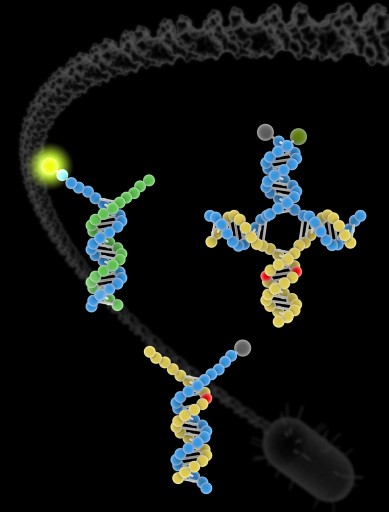Breakthrough in detecting single DNA mutations
July 30, 2013

This conceptual image shows probe and target complexes at different stages of the reaction that checks for mutations. The red dots represent mutations in a target base pair, while the illuminated green light indicates that no mutation was found. (Credit: Yan Liang/L2XY2.com)
Researchers have developed a new method that can look at a specific segment of DNA and pinpoint a single mutation, which could help diagnose and treat diseases such as cancer and tuberculosis.
Modern genomics has shown that just one mutation can be the difference between successfully treating a disease and having it spread rampantly throughout the body.
These small mutations can be the root of a disease or the reason some infectious diseases resist certain antibiotics.
“We’ve really improved on previous approaches because our solution doesn’t require any complicated reactions or added enzymes, it just uses DNA,” said lead author Georg Seelig, a University of Washington assistant professor of electrical engineering and of computer science and engineering.
“This means that the method is robust to changes in temperature and other environmental variables, making it well-suited for diagnostic applications in low-resource settings.”
Detecting mutations in a single DNA base pair
Seelig, along with David Zhang of Rice University and Sherry Chen, a UW doctoral student in electrical engineering, designed probes that can pick out mutations in a single base pair in a target stretch of DNA. The probes allow researchers to look in much more detail for variations in long sequences — up to 200 base pairs — while current methods can detect mutations in stretches of up to only 20.
“In terms of specificity, our research suggests that we can do quadratically better, meaning that whatever the best level of specificity, our best will be that number squared,” said Zhang, an assistant professor of bioengineering at Rice University.
The testing probes are designed to bind with a sequence of DNA that is suspected of having a mutation. The researchers do this by creating a complementary sequence of DNA to the double-helix strand in question. Then, they allow molecules containing both sequences to mix in a test tube in salt water, where they naturally will match up to one another if the base pairs are intact.
Unlike previous technologies, the probe molecule checks both strands of the target double helix for mutations rather than just one, which explains the increased specificity.
The probe is engineered to emit a fluorescent glow if there’s a perfect match between it and the target. If it doesn’t illuminate, that means the strands didn’t match and there was in fact a mutation in the target strand of DNA.
The researchers have filed a patent on the technology and are working with the UW Center for Commercialization. They hope to integrate it into a paper-based diagnostic test for diseases that could be used in parts of the world with few medical resources.
The research was funded by the National Institutes of Health, the National Science Foundation and the Department of Defense’s Advanced Research Projects Agency.